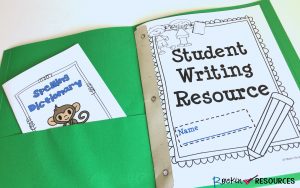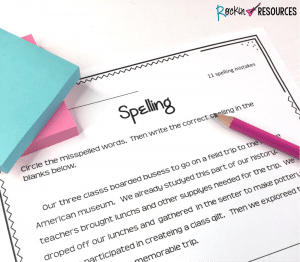Are you looking for teaching ideas for proofreading spelling? Students should edit their rough drafts using CUPS (Capitalization, Usage, Punctuation, Spelling) and this lesson focuses on the S for spelling. It is part of a writing mini lesson series for writing workshop and works well with any writing curriculum. Read on for spelling rules and proofreading tips.
Editing is an important step in the writing process and correct spelling is a part of this step. Find ways to teach students to proofread their rough drafts for spelling.
1. TEACH
Display an anchor chart or charts with spelling rules. Review them with your student(s). Then post it on a bulleting board or writing center.
SPELLING RULES
- Always put a u after a q. (quack, quiet)
- Every syllable has a vowel.
- The “soft” sound of c (s sound) or g (j sound) is usually followed by i, y, or e. (city, gym)
- Write i before e except after c or when sounded like a. (thief, believe, ceiling, receive, neighbor, weigh)
SPELLING RULES FOR ADDING INFLECTIONAL ENDINGS TO WORDS
- Most words- Add the ending. (talk-talked)
- Words ending in a single vowel and consonant- Double the final consonant and add the ending. (stop- stopped, stopping)
- Words ending in silent e- Drop the e before adding the ending. (bake, baked, baking)
- Words end in a consonant and y- Change the y to i then add the ending unless the ending is -ing. (hurry- hurried, hurrying)
- Words that end in ss, ch, sh, zz, or x- Add -es. (foxes, wishes)
2. MODEL
Model these rules by correcting them in your class story’s rough draft. If you didn’t make mistakes along the way, not problem! Take your rough draft and find places to make errors. Then show your students how to correct them. Don’t forget to talk out loud so your students can hear your thought process!
3. TAKE NOTES
Students should take notes on the SPELLING rules or provide a mini anchor chart of the rules for students to paste in their notebooks. Also include the rules in a student writing resource to use in writing centers or homework.
4. PRACTICE
Students should practice proofreading text that has spelling mistakes.
5. APPLY
Students are now ready to apply their knowledge of spelling rules and apply them to their own writing rough drafts. Bring out the magnifying glasses if you want to motivate your little detectives!
6. SHARE
Quickly have students share in small groups or partners where they found spelling errors. It may help the reluctant editors!
Did you learn a few things to help your students with proofreading rough drafts for spelling?
Check out my FREE writing masterclass! CLICK HERE
LAST LESSON: WRITING MINI LESSON #35 CUPS FOR EDITING- PUNCTUATION
NEXT LESSON: WRITING MINI LESSON #37- PEER REFLECTION
CLICK HERE FOR THE FULL LIST OF WRITING MINI LESSONS
This lesson is also included in the STEP-BY-STEP WRITING® Program with mini-lessons designed to scaffold through the writing process. Writing units included are sentence structure, paragraph writing, narrative writing, opinion writing, and informative writing. See what is included in the image below and click on it to learn more about them! You will turn your reluctant writers into ROCKSTAR WRITERS™!
“I’m British so usually quite reserved and not gushy at all but… oh my goodness this is a totally magnificent resource and I think I love you! Writing was always something of a nightmare for me, either I was niggly about it or the class were but I can’t rave enough about how your hard work has helped change all that. The kids love the work, it’s easy to follow and mark, and I really feel that I am actually teaching them something. Thank you so much!!!!” -Michelle B.









